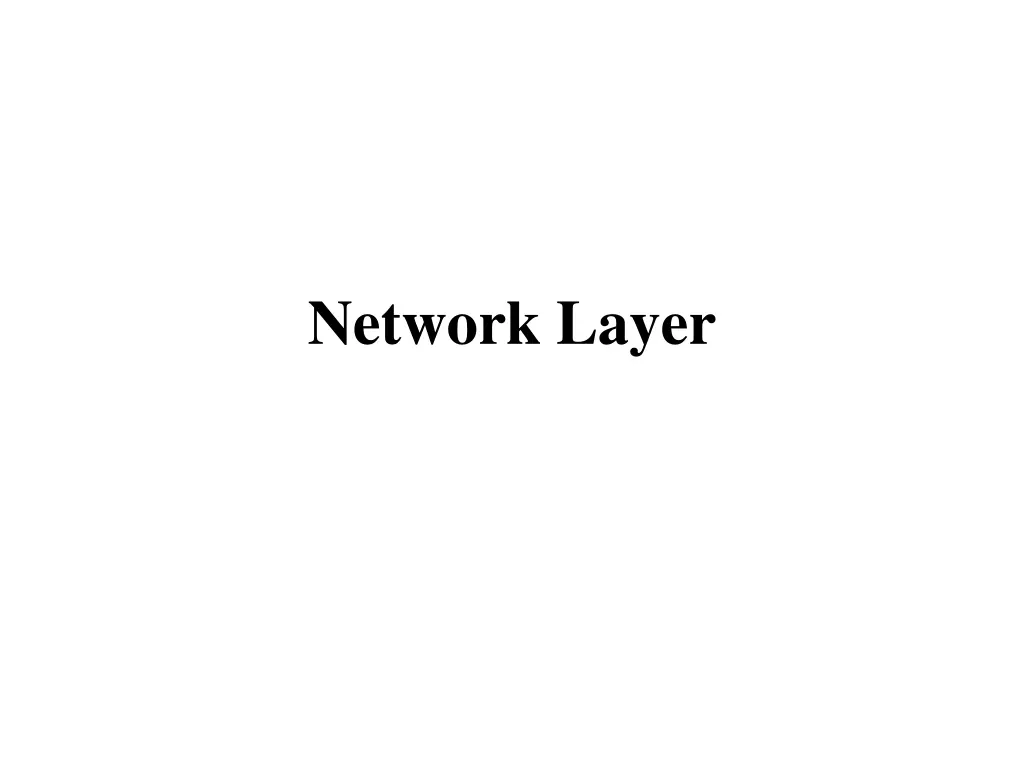
Understanding Network Layer Protocols and Addressing
Explore the world of network layer protocols such as ARP, ICMP, and IGMP, and learn about IP host-to-host delivery. Discover the significance of hardware addresses in identifying devices connected to the internet, along with IP and physical addresses. Dive into ARP's role in mapping network to physical addresses and the operation of Address Resolution Protocol in networking scenarios.
Download Presentation

Please find below an Image/Link to download the presentation.
The content on the website is provided AS IS for your information and personal use only. It may not be sold, licensed, or shared on other websites without obtaining consent from the author. If you encounter any issues during the download, it is possible that the publisher has removed the file from their server.
You are allowed to download the files provided on this website for personal or commercial use, subject to the condition that they are used lawfully. All files are the property of their respective owners.
The content on the website is provided AS IS for your information and personal use only. It may not be sold, licensed, or shared on other websites without obtaining consent from the author.
E N D
Presentation Transcript
IP Host to host delivery. It holds whole internet together in the n/w layer protocol. IP takes help from other protocols such as ARP,ICMP,IGMP It is basically unicast delivery but multicast for internet and multimedia applications. IP4 and IPV6 versions.
H/w addresses To identify each computer connected to internet physical addressing is used(h/w address). 3 methods Static address Configurable addresses Dynamic addresses.
IP addresses IP address Physical address
ARP Resolution of network layer addresses into link layer addresses. Mapping a network address (IP address) to a physical address like an Ethernet address (MAC address) It is defined in RFC 826 standard.
Mapping Static mapping Dynamic mapping(ARP and RARP)
Operation of ARP Sender is host and wants to communicate with another host on same n/w. Sender is host and wants to communicate with another host on different n/w. Sender is router and receives a datagram with destination address of host on different n/w. Sender is router and receives a datagram with destination address of host on same n/w.
ARP Operation Sender knows IP address of target. Sender creates ARP request. ARP packet is sent to data link layer.ARP request is inserted into frame. Frame is broadcasted so every router and host receives this frame. Target machine give reply(unicast) which contains target s physical address. Sender receives reply , data is inserted into frame and frame is unicast to destination.
Internet protocol Host to host delivery protocol. Connectionless datagram protocol. IP can detect error. For reliability IP is paired with TCP. Each IP datagram is handled independently.
RIP Disadvantages of RIP: It works well in small system. Suffered from count to infinity problem. Slow convergence.
OSPF Open shortest path first. It is main interior gateway protocol. It supports variety of distance metric such as physical distance , delay etc. It is dynamic algorithm-changes in topology are dynamically and quickly. It support routing based on type of service. It provides load balancing. Supports for hierarchical system. It able to route real time traffic in one way and other in different way.
Working OSPF operates by abstracting collection of actual networks ,routers and lines into a directed graph (arc has cost) and find the shortest path between routers.
Three kind of connections Point to point lines between exactly two routers. Multi access networks with broadcasting. Multi access networks without broadcasting.
OSPF allows internet to divide into areas. Area-network or set of continuous network. Areas are not overlapped but some routers may belong to no area. Each AS has a backbone area (area 0). All areas are connected to backbone by tunnels. Transmission between two areas is done through backbone. Tunnel is represented by arc and cost.
Within each area, each router has same link state database and runs same shortest path algo. A router that connects two areas need the database for both areas and runs shortest path algo. for each one separately.
Kinds of Routers Intra-area Inter area Inter-AS
OSPF classes of routers Internal routers are wholly within one area. Area border routers connect two or more areas Backbone routers are on the backbone. AS boundary routers talk to routers in other Ases.
Additional Hierarchy OSPF permits additional hierarchy by permitting domain is divided into area So router needs to know how to reach the right area. Decrease in amount of information transmitted and stored.
Load balancing OSPF permits multiple routes to same place are assigned with same cost. Traffic is spread evenly over routers.
OSPF messages Hello: used to discover neighbor. Link state update: Provides sender s cost to it s neighbor. Link state ack: acknowledged link state update. Database description : announces which updates the sender has. Link state request : request info. from partner.
RIP OSPF RFC 1058 No link state protocol Hop count is large metric(16) Updating routing table at every 30 sec. Dead interval is 300 sec No authentication No variable length subnets No supernetting No TOS No multi path routing Easy to use n/w diameter RFC 2178 link state protocol 1-65535 Link state update at every 30 sec Dead interval is less 300 sec provides authentication Variable length subnets. Supenetting can TOS is present Multi path routing is possible. Not easy to use
BGP Border gateway protocol. Exterior gateway routing protocol. Certain policies are considered.(no transit traffic through certain Ases)
Internet consist of ASes and line connecting them. Two Ases are connected if line between border router of each one.
Type of BGP network Stub network.-one connection with BGP graph and not used for transit. Multiconnected network: Transit n/w:such as backbone and willing to handle third party packets.
Working Pair of BGP routers communicate by establishing TCP connection.(hides details). BGP is distance vector protocol. It maintains both cost and path. Each BGP router tells it s neighbor exact path it is using.
